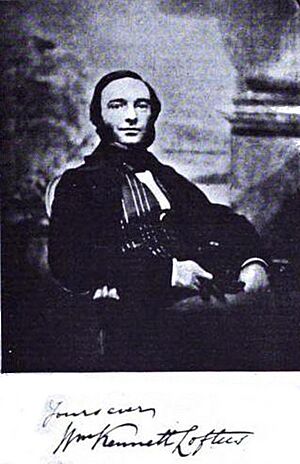William Loftus facts for kids
William Kennett Loftus (born November 13, 1820, died November 27, 1858) was a British expert who studied rocks (a geologist), nature (a naturalist), and explored new places. He was also an archaeologist, meaning he dug up old cities and artifacts.
He is famous for finding the ancient Sumerian city of Uruk in 1849. This was a very important discovery!
Contents
About William Loftus
William Loftus grew up in a town called Rye in England. He went to school at Newcastle Royal Grammar School. Later, in 1840, he went to Cambridge University to study geology, which is the study of Earth's rocks and history. In 1845, he got married to Charlotte Thulbourne.
Exploring Ancient Lands
In 1849, William Loftus joined a British government team called the Turco-Persian Boundary Commission. This team was working to draw the border between Turkey and Persia (modern-day Iran). Being part of this mission gave Loftus and his friend Henry Adrian Churchill a great chance to visit many ancient sites.
In 1850, they spent a month digging at two very old cities: Uruk (also known as Warka) and Larsa (also known as Senkereh). During these digs, they found the Ziggurat of Ur, which is a huge, ancient temple tower.
Discoveries at Susa and Warka
For a short time in 1851, Loftus was allowed to leave the border commission to dig at Susa. He was working for the British Museum. Later, another archaeologist named Hormuzd Rassam took over. Loftus and Rassam then worked together to explore the sites and write a report about their findings at Susa.
Loftus is given credit for finding the Apadana at Susa. This was a large audience hall in an ancient Persian palace.
In 1853, a new group called the Assyrian Excavation Fund hired Loftus. From January to April 1854, he worked at Warka (Uruk) again. There, he uncovered a famous wall made of colored clay cones. He also found some ancient tablets with writing called cuneiform script.
Finding the Burnt Palace
In October 1854, Loftus moved his work to Nineveh. He also worked at another site called Nimrud. In February 1855, he made an exciting discovery: he found what is known as the "Burnt Palace." This palace belonged to the Assyrian king Ashurnasirpal II. Inside, he found a collection of beautiful ivory carvings.
Sadly, William Loftus's health began to decline. In September 1856, he started a new job as a geologist in India. But he became very ill there. He died at sea in 1858 while sailing back to Britain. He was only 38 years old.


